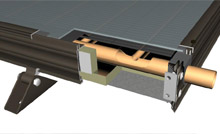Solar Systems Use Copper to Harness Sun's Energy
From the collector to the tubing, copper is the driving force in solar water heaters
There are about 1.5 million solar water heaters being used in U.S. homes and businesses today. According to the Environmental and Energy Study Institute (EESI), with the availability of solar energy, the U.S. is capable of installing another 29 million solar water heaters with location and climate taken into consideration.
Given the right location, solar water heating systems (SWH, or solar thermal systems) can cut a users energy costs significantly. Besides the energy savings benefit to each user, solar thermal systems and their offset in energy use benefit the community as a whole by reducing the carbon emissions associated with the power production previously used for water heating. Recognizing the benefits of solar water heating, state and federal incentives and rebates exist to promote their installation by households and businesses.
There are several different systems available, which can vary on the type of collectors they use and where they are installed, but copper remains the one material that is a mainstay for all SWH systems.
"The two most common uses for copper in solar systems are the collector itself, specifically the absorber sheet or fin, as well as the tubes that are attached to the sheet or fin," said John Harrison of the Florida Solar Energy Center (FSEC). "Copper is a good fit because of its good heat transfer properties and long-term durability. It's easy to work with and amenable to soldering or brazing."
Copper also plays a key role in the tubing that connects the collector to the water storage and distribution system inside the building. As water temperatures in the collector can become quite high during the heat of the day, many materials, such as some of the common plastic piping materials, can't handle the high temperatures and pressures in the system. Copper's superior strength at these temperatures make it the ideal choice.
Copper is the driving force for the most important part of a solar water heating system: the collector. While there are many different types of systems, the basics on how a solar system works are fairly simple. As sunshine strikes the collector, the water inside is heated. There is a pump that moves water from the tank through the collector and back into the tank. As the sun's intensity changes throughout the day, the circulating pump also changes its speed accordingly. By the end of the day, the water in the tank has been circulated many times through the collector and has been heated to usable hot water temperatures. For colder weather, heat exchangers are incorporated in the design, which are also copper-intensive.
While the differences in solar water heating systems can change depending on location or system size, copper plays a vital role from the collector to the tubes running through it. The basic thermal conductivity, longevity, and workability characteristics make copper the perfect metal for solar thermal production. Cu
Also in this Issue:
- Habitat for Humanity Goes Green
- Alternative Joining Systems Meet the Challenge
- Feel the Breeze
- Copper Joins the Huddle
- Solar Systems Use Copper to Harness Sun's Energy

 Provided by the Florida Solar Energy Center (FSEC)
Provided by the Florida Solar Energy Center (FSEC)